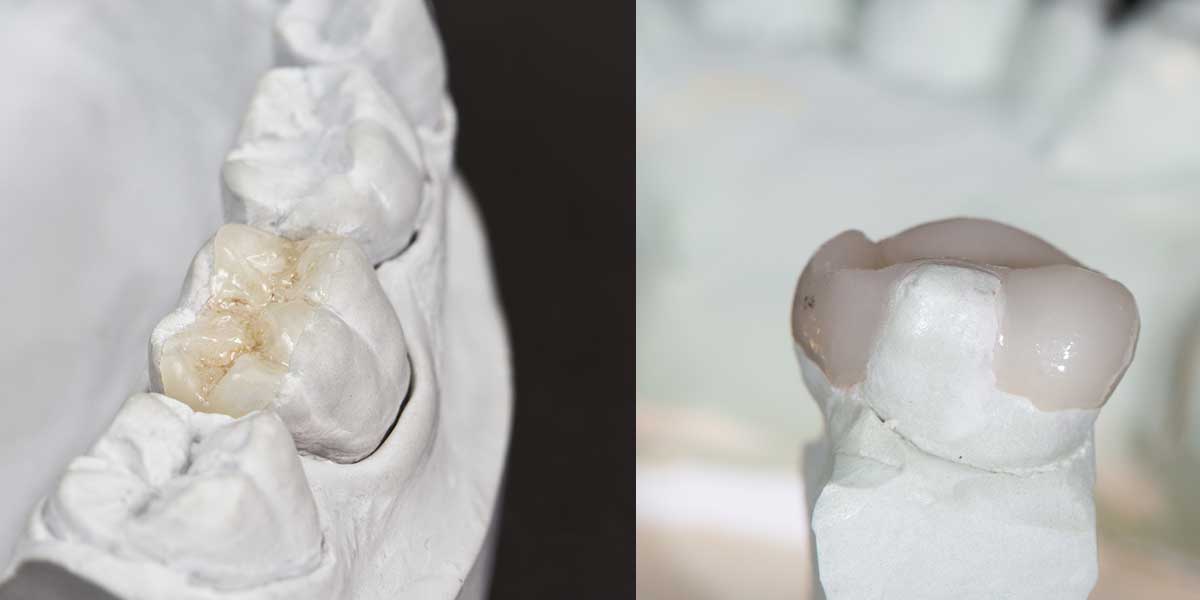Inlays and Onlays in Stuart, FL

Stuart Prosthetic Dentistry provides inlays and onlays in Stuart, FL. Call our office today at 772.286.1606 to schedule an appointment.
If you’re looking for a more durable and long-term solution than a filling, then you should consider an inlay or onlay.
As a Certified Dental Technician (CDT) before he became a dentist, Dr. Tyler gained invaluable experience, working several years in a dental lab. As a lab technician, he specifically specialized in fabricating crowns and bridges. This lab specialty includes the fabrication of inlays and onlays. These experiences are noticeable when you receive the technically proficient treatment he provides for his patients, particularly when doing inlays and onlays.
What are dental inlays and onlays?
Dental inlays are used instead of fillings to replace a small amount of tooth structure lost due to decay. Like fillings, inlays fit inside the tooth.
Like inlays, onlays also fit inside of the tooth, but additionally extend onto the chewing surface of a back tooth to replace one or more cusps. Onlays are often used as a more conservative option to a dental crown, since they don’t require as much removal of tooth structure.
What are dental inlays and onlays made of?
Traditionally, inlays and onlays were only made of gold. Today, due to patient demands for more esthetic solutions and evolution of dental materials, they can be made of tooth-colored materials such as porcelain, ceramic, or dental composite resin. In addition, making an inlay or onlay of porcelain, ceramic, or dental composite allows the restoration to be bonded directly to the tooth. The bonding process improves the strength of the tooth and helps to seal the restoration to the tooth. Often, defective or unsightly old silver fillings can be replaced by tooth-colored inlays or onlays.
How are dental inlays and onlays done?
In the past, the process of delivering an inlay or onlay took two to three visits to the dentist. It included messy impressions, a temporary restoration, and a 2 to 3 week waiting period for a dental lab to fabricate the finished restoration. The impression material, stone models, wax, and metal casting, required in this traditional approach all induce inaccuracies (although clinically acceptable) into the finished lab-made inlay or onlay. Often, many chairside adjustments to the lab-made restorations are required to correct those inaccuracies upon delivery. The temporary inlay or onlay that is worn for the lab waiting period can also be a hassle for many patients. While you have a temporary restoration, the tooth may be more sensitive to hot and cold and you will be told to avoid sticky and crunchy foods.
Today, using CEREC, an advanced dental technology, inlays and onlays can be made of tooth-colored materials (porcelain, ceramic, or dental composite) in a single visit. Apart from speeding up the process, CEREC restorations are 50 percent more accurate than lab-made ones. This is because with CEREC the impression is made by digital scanning of the teeth and then the restoration is virtually designed and milled (CAD/CAM). This digital process eliminates the need for impressions, stone models, wax, and metal, including their inaccuracies. In addition, a temporary restoration and second appointment is not needed.
How long do dental inlays and onlays last?
On average, inlays and onlays tend to last between 5 and 15 years, but some cases last up to 30 years. However, like natural teeth and other restorations, inlays and onlays can break and the tooth can still get cavities. The lifespan of a restoration often depends on your commitment to at-home care and professional dental hygiene visits, and other oral habits, like teeth grinding. In many cases, a night guard is indicated to protect your restorations.
It is difficult to determine when inlays and onlays can be used instead of crowns. Ask a prosthodontist, like Dr. Tyler, if you are a candidate for a tooth-colored inlay or onlay.
